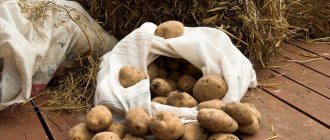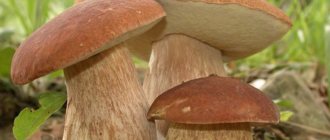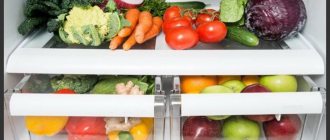Author: Elena N. https://floristics.info/ru/index.php?option=com_contact&view=contact&id=19 Category: Garden plants Published: November 15, 2015Last edits: January 06, 2021
- Preparation for storage
- Preparation for storage
- Preparation for storage
- Preparing garlic for storage
- Preparation for storage
- Preparing zucchini for storage
- Preparation for storage
- Storing sweet peppers
- Preparation for storage
- Storing nuts in shell
Once the harvest is over, the question arises of how and where to store it during the winter, because you spent a lot of time and effort growing fruits and vegetables, hoping that in winter you would be able to enjoy the fruits of your labor. If you follow simple rules, you can achieve long-term storage of the harvested crop, while ensuring that fruits and vegetables do not lose their taste and beneficial properties for as long as possible. We will tell you in this article how to properly store crops in the winter, where it is better to store root crops, in what conditions and for how long you can store certain vegetables and fruits.
How to store carrots in winter
Preparation for storage
It is better to dig up carrots with a pitchfork so that there is as little damage as possible on the fruits. The tops are cut off from the dug carrots and the roots are left to dry for two weeks in the shade at a temperature of 10-14 ºC. During this time, you will have the opportunity to determine which carrots are spoiled and remove them from the total mass intended for storage.
Before storing, root vegetables are dipped in a weak solution of potassium permanganate for half an hour and then allowed to dry. A layer of river sand 2-4 cm thick is poured into wooden boxes, a layer of carrots is placed on it, then a layer of sand 4-5 cm thick is again poured on top of the carrots, on which a layer of carrots is again laid, and so on until the box is full . Root vegetables in boxes should not touch each other. No more than 15 kg of carrots are placed in each container. The carrots are laid out for wintering with a layer of sand. Instead of sand, you can use sawdust or rowan leaves.
How to store in the cellar
Boxes with sand and carrots are lowered into the cellar. The optimal conditions for storing carrots are considered to be a temperature of 0-4 ºC and air humidity of about 90%. If the temperature is higher, the carrots begin to grow. Sometimes carrots are stored in 50 kg bags in tight polyethylene bags, which are not tied to avoid condensation.
- How to correctly calculate the timing of sowing seeds so that the seedlings do not overgrow, but also do not lag behind in growth?
Storing carrots until spring in a fresh and juicy state is carried out in another way: add 4 liters of water into a ten-liter bucket, half filled with clay, mix it thoroughly with the clay and leave for half a day, then add water again, mix it with the clay mixture and give Let it sit for a day so that the composition acquires the consistency of sour cream. A layer of carrots is laid out in a wooden box covered with polyethylene and filled with clay solution, then the next layer is laid out, which is again covered with liquid clay - this method preserves carrots, preserving their appearance and taste.
Winter storage in an apartment
If you do not have a cellar, or it is not suitable for storing carrots, place the root vegetables in cardboard boxes, sprinkle generously with sand or onion-garlic peels and place them in the pantry. You can keep carrots on the balcony in winter, putting them in glass jars, and if frost hits, cover the jars with lids.
Features and methods of storing vegetables of the Onion family (with photos)
For long-term storage of vegetables from the Onion family, you must first of all choose the right variety. It is known that hot onions, which contain more dry substances and essential oils, are better stored. Keeping quality is affected by growing conditions. Thus, onions grown on fertile soils of loamy or sandy loam mechanical composition, well seasoned with organic fertilizers, are perfectly stored.
Onion harvest
Harvesting is carried out at a time when most of the plants have yellowed and fallen leaves, choosing a dry sunny day for this. Immediately after harvesting, the onions must be thoroughly dried until they, as people say, “rust.” At this time, its humidity when storing vegetables will be approximately 14-15%, which is the optimal condition for long-term storage. After which the feathers are cut off at a height of 4-5 cm, and the onion is dried again in the sun or in a heated room until the neck becomes dry to the touch. Then the onions are sorted, selecting heads that are damaged or affected by pests and diseases for processing.
How to store beets in winter
Preparation for storage
Before storing beets, the tops are cut off, leaving only 2-3 centimeters of petioles, as well as a central rosette of small leaves, then the root crops are placed in rows in a box on the sand, sprinkling each row with a layer of sand, sawdust or peat, as is done with carrots.
How to store it in the cellar
Boxes with beets sprinkled with sand (peat, sawdust) are stored in the cellar at a temperature of 2-3 ºC and an air humidity of 80-85%, making small holes in them and placing them on a stand 15-20 cm high. Do not move the boxes close to the wall - air must circulate freely.
How to store at home
Beetroot can be stored in any other cool, but not cold, room - on an unheated veranda, glassed-in loggia or balcony. A loosely closed bag or box with beets is placed in a dark place. But with such storage, the need to regularly check stored root vegetables increases.
Tips and tricks for preserving beets at home in winter
At home, beets can be stored in the refrigerator if you only have a small amount. Place it in a plastic bag and place it in the vegetable drawer of the refrigerator. The bag with beets should not be tightly tied. Beetroot can be stored in the refrigerator for 2-4 months.
DIY special cabinet for vegetables
Finally, the storage of vegetables and fruits can be organized in any old cabinet, having the foresight to make “windows” in it with wire mesh. These windows allow air to circulate and allow you to see what's hidden inside each compartment. Look at the photo to see how you can make such a cabinet for vegetables with your own hands:
How to store cabbage in winter
Preparation for storage
For winter storage, mid-ripe, mid-late and late-ripening varieties of cabbage harvested on time are suitable, and it is best to remove cabbage from the garden when the outside air temperature reaches 5-0 ºC - at this time breathing slows down inside the head.
Storing cabbage requires preliminary preparation of heads of cabbage. The forks are removed by the roots, sorted, selecting only dry and dense ones. Heads that do not meet these characteristics, as well as heads of cabbage that have mechanical damage, cannot be stored - they can rot themselves and infect healthy forks with rot. Substandard cabbage can be salted. Before storing cabbage in the basement, the top green leaves are cut off and the heads are dried for several days in a draft in a suspended state.
How to store in the cellar
Cabbage is also stored in the basement suspended from the ceiling, tying two heads of cabbage together. It is best to store cabbage at a temperature of about 0 ºC and very high air humidity - almost one hundred percent. You can arrange the heads of cabbage for storage in the cellar on shelves or racks, removing the roots and wrapping each head in paper. Newspaper is not suitable for wrapping because printing ink contains harmful substances. You can put each head in a plastic bag along with a wad of paper.
In winter, you need to regularly inspect stored forks and remove leaves that have begun to rot. You can use the method of pre-processing cabbage with a clay mash: heads of cabbage are dipped into a clay solution with the thickness of pancake batter, which are then hung in the yard to dry. Dried, clay-treated forks are transferred to the cellar, where they are hung from the ceiling. An interesting way to store cabbage was invented in Moscow: ordinary plastic curlers are inserted into perforated heads of cabbage, after which the cabbage is placed in a cellar or in a refrigerator, where it is pressed down with a weight that promotes gas exchange.
From time to time the load is lifted and then placed on the cabbage again.
How to store in the ground
In areas with warm winters, cabbage, having removed non-adjacent green leaves from it, is placed in a trench dug in the garden with the stalks up and covered with a 10 cm thick layer of earth. With the onset of cold weather, the layer of earth is increased to 30 cm.
- Preventive treatment of cucumbers with a solution of whey and ammonia
In cooler areas, a triangular wooden box with a side length of 50 cm and a height of about a meter is knocked together to store cabbage in the fresh air. The box is placed on a flat surface, a layer of pine needles is poured onto its bottom as protection against rodents, on which cabbage is laid in three rows. The top of the cabbage is again covered with pine needles, then straw, then peat or sand. In extreme cold, the box is lined with bags of hay, and snow is piled on top.
How to store onions in winter
Preparation for storage
Onions are harvested when their leaves lie down and begin to turn yellow. Do not wait for the leaves to completely dry out, as rain may begin, and the onions will not be stored well after that. After harvesting, the bulbs are dried for a week, then the feathers are cut off, leaving a neck 5 cm long. Storing onions with a damp top layer of scales, as well as those bulbs that have grown at least one arrow, is contraindicated. A dangerous sign are small flies - if they appear, carefully inspect the bulbs and look for a rotting one.
How to store at home
How to store leeks at home? A small amount of onions is stored in a box with onion peels, which will prevent the bulbs from drying out. If the harvest is large, scatter the bulbs on the floor of a warm, dry room in one layer and store them at a temperature of 18-20 ºC with an air humidity of 60-70%.
You can also store onions in wooden boxes, mesh bags, in oversized tights or braided in a suspended state, but in this case the leaves from the onion are not trimmed. Onions should not be stored in several layers, as this will cause the bulbs to fog up and spoil. Stored bulbs need to be well ventilated. Never use plastic bags to store onions.
Storage conditions for tomatoes
Tomatoes collected in the fall will be stored in a dark, dry place, laid out in a single layer with the stems facing up. Green tomatoes that have not yet ripened should be placed in flat wooden boxes and kept on the floor, where it is cool and dark. The temperature should be above zero. It is believed that the proximity of green tomatoes to red ones accelerates the redness of the former.
You can also keep these tomatoes until the new year by selecting the healthiest green fruits and wrapping each one in paper and placing it in a box covered with straw or torn paper, with the stems facing up. Store in the dark at +11-13°C until they turn red.
How to store garlic in winter
Preparing garlic for storage
The most important condition before storing garlic is to dry it for a long time, but preparation for storage begins with timely harvesting of the garlic - this must be done before the heads begin to disintegrate into cloves. If you find any broken heads of garlic, use them first.
How to store at home
Garlic is stored in linen or calico bags suspended from the ceiling. It is also stored braided, like onions. Oversized tights or stockings can be used as a breathable container. Since garlic is somewhat more capricious than onions, before putting it into bags or stockings, garlic is subjected to special treatment at home - dipped in molten paraffin. The resulting film will protect the head from drying out and protect against infection by pathogens.
Ventilate the room where the garlic is stored, inspect and feel the heads to promptly identify any that are spoiling or sprouting. To prevent garlic from starting to grow, you can burn its roots.
If you don’t have a lot of garlic, you can peel the cloves and put them in a jar of sunflower oil for storage - and the oil will acquire a pleasant taste and the garlic will be perfectly preserved. In the same way, you can store peeled garlic in a jar with flour.
Pantry
If the kitchen area allows and you decide to make a pantry in its space, then this will help create additional space for storing vegetables. For a large and hospitable family, in this case, there is no reason to worry that the vegetables will have time to spoil at room temperature; everything will quickly be consumed. Whether it is worth creating such places for vegetables for a small family is a controversial issue.
How to store pumpkin in winter
Preparation for storage
Pumpkin does not need any preparation for storage. Storing pumpkins does not require low temperatures, but not every pumpkin can be preserved until spring. For example, thin-skinned vegetables can only be stored until January, and then their seeds begin to germinate. In addition, only intact, undamaged specimens are suitable for storage.
How to store at home
At what temperature should pumpkins be stored? The optimal temperature for storing them is 5-8 ºC, although a temperature range from 1 to 14 ºC is acceptable. If you have to store them in cooler conditions, line your pumpkins with straw. Actually, hard-bark varieties of pumpkins, like zucchini, can be placed on a cabinet or rolled under the bed, where they can be stored not only until spring, but also until the next harvest. Can be used for storage in a dry attic. Store the cut pumpkin in the refrigerator.
Temperature conditions and types of storage of cabbage vegetables
Various representatives of a large family are irreplaceable on our table, but the most popular in Russia are white, red, and cauliflower. The modes and methods of storing these vegetables have a number of differences. So how to properly store vegetables from the cabbage family of different types?
Storing white cabbage
White cabbage. Late-ripening, or so-called winter, varieties of cabbage are suitable for long-term storage. It is very important to harvest the crop on time, since numerous studies have established that respiration in cabbage heads collected at a temperature of 0 - +5 ° C occurs least intensively and, therefore, they are better stored. Frozen cabbage will not last long, just like cabbage that has cracked due to prolonged watering or prolonged rains.
How to store zucchini in winter
Preparing zucchini for storage
You must have time to collect zucchini before frost sets in, because even slightly frozen vegetables are unsuitable for long-term storage, just like thin-skinned zucchini varieties. When removing zucchini, leave a stalk 5-6 cm long, since its appearance can determine the condition of the vegetable in winter. Zucchini intended for storage are not washed; the soil is only removed from them.
How to store in the cellar
The optimal temperature for storing zucchini is considered to be from 4 to 10 ºC. Storage is carried out in a place inaccessible to the sun - basement, cellar, cold storage room, balcony, unheated veranda, loggia, etc. Zucchini is laid out for storage in a single layer on racks, shelves, tables and other horizontal surfaces, previously covered with wax paper or sprinkled with hay. Zucchini should not touch each other, then they will be stored until spring. However, already in March, the seeds inside the zucchini begin to germinate, so try to eat zucchini before the beginning of spring.
“Refrigerator” under the window (in Khrushchev buildings)
If you live in a so-called Khrushchev apartment, then you immediately understand what we are talking about. The cabinet under the kitchen window was specially planned by engineers at one time so that food could be stored there.
During cold seasons, such a “refrigerator” maintains the optimal temperature, even if only for 5-6 months, but such a place will be a good help for storing additional volumes of food.
Let's move on to the second group of storage locations.
How to store potatoes in winter
Preparation for storage
Before storing potatoes, they need to be prepared: dried for several days in the shade, under a canopy, with good ventilation. Then the potatoes are sorted, rejecting rotten, spoiled and damaged tubers, and only after that the potatoes are transferred to the barn. Potatoes are lowered into the cellar when the outside air temperature drops to 3-5 ºC. If you do this earlier, it will begin to sprout earlier.
How to store potatoes in the cellar
Many people store potatoes by pouring them on the floor in the cellar, but it is better to place them in mesh boxes or containers with perforations in the walls for ventilation so that air can reach the tubers. The height of such containers should be no more than 1 m, and they should be installed not on an earthen floor, but on stands 15 cm high. The distance from the box to the nearest wall or to another box is maintained at least 20 cm.
- Processing seedlings in THREE stages – effective prevention against diseases and pests!
All these measures are taken to ensure that air reaches the tubers in sufficient volume and the potatoes do not rot. You can sprinkle the tubers in boxes with dry sawdust or crushed rowan leaves: the sawdust absorbs unnecessary moisture, and the phytoncides secreted by the leaves kill harmful microbes. The top of the boxes with potatoes is covered with burlap, which is changed to dry as it accumulates moisture. You can also put layers of horseradish and beets under the burlap - from such proximity the root vegetables will not dry out and the potatoes will not get wet.
Under the sink
There is usually always free space under the sink, so it can also be used for storing vegetables. Vegetables such as potatoes, onions, garlic, carrots and beets can easily get along in such a place for a short period of time. The easiest way is to put the vegetables in a basket or, for example, a plastic container.
You can install a pull-out storage system based on plastic drawers under the sink.
How to store peppers in winter
Storing sweet peppers
How to store pepper in an apartment? The pepper is freed from seeds, dried and placed in the freezer to freeze. You can freeze whole peppers by inserting one peppercorn into another, or you can cut the vegetables into pieces before freezing. It is also possible to store sweet peppers for two months in a dry basement at a temperature of 10-12 ºC, if you put them in layers in a box, interspersing each layer with thick paper. They also use this method of short-term storage: they put the peppers in plastic bags, but do not tie them, leaving air access to the pepper.
Storing hot peppers
Hot pepper pods are collected in dry weather before frost. They are stored for 40 days in polyethylene bags perforated along the entire perimeter at a temperature of 0 to 2 ºC with an air humidity of 85-93%. You can hang pepper bushes, extracted from the ground with roots, on a balcony, loggia or veranda with their roots up at a temperature of 10-12 ºC for 2-3 weeks, and then, as the fruits acquire maturity and the desired color, they are moved to storage in the same position in cooler conditions - 0-2 ºC, at the specified humidity level. This way the pepper can be stored for a very long time.
Fabric bags
Many housewives will like cute handbags, as they will not only be practical, but will also decorate the kitchen interior. They are made of canvas fabric, allow air to pass through well and prevent the formation of mold. They do an excellent job of storing small amounts of garlic, onions and potatoes.
Now let’s look at the vegetables themselves separately.
How to store apples in winter
Preparation for storage
How long your apples will be stored depends not only on the conditions you create for them, but also on the variety of apples themselves. If stored properly, some varieties can last for six months, while others can last no more than two to three months. The varieties Antonovka ordinary, Jonathan, Melba, McIntosh, Starking, Northern Sinap, Simirenko and others are intended for long-term storage.
In order for apples to be stored as long as possible, they must be picked correctly from the tree:
- apples are not squeezed with fingers, crushed or scratched: they are grabbed with the entire palm, slightly lifted and scrolled;
- It is advisable to pick off the stalks along with the apple;
- the picked fruits are carefully placed in containers for collection, trying not to injure them - do not throw or crush them;
- They begin cleaning in dry weather from the lower tier of the tree.
After picking, the apples are sorted by size. Large ones are left for long-term storage, medium-sized apples, which are stored a little worse, are tried to be eaten first, and the smallest fruits are sent for processing - jams, preserves, preserves, compotes and ciders are prepared from them. Keep in mind that apples from mature trees on the outside of the canopy, which receive more sunlight, will keep longer and better. Weather conditions during the ripening period of apples also affect the quality and shelf life of the fruit.
Basement storage
The optimal temperature for storing apples is 0-3 ºC, and air humidity should be no higher than 90%. At higher temperatures, apples begin to turn yellow. Before storing apples, they are cooled in the refrigerator or basement. The walls and ceiling of the vault need to be whitewashed, and the floor treated with a solution of iron sulfate.
Additionally, before storing, you can grease the apples or treat them with melted paraffin, as is done when storing garlic - these measures will help protect the crop from pests and from wilting. It is best to wrap each apple in paper and place them, stems up, in dry, clean containers - wooden lattice boxes, moisture-resistant cardboard boxes or wicker baskets. With this storage, rot or disease from a diseased apple will not spread to neighboring fruits.
You can arrange the apples with their stems to one side in a container in layers, placing each layer with paper, straw or wood shavings. Apples are also stored in boxes with sand, like carrots or beets: a layer of sand at least 20 cm high is poured onto the bottom, on which the apples are laid out in one layer. The apples are covered with sand so that they are completely hidden, and then the next layer of apples is laid out on them, etc. Filled boxes are installed along the walls in two floors with a gap of about 2 cm between them.
Storing apples in the garden
If you do not have the opportunity to store apples in a basement or cellar, put one and a half kilograms of them in plastic bags, placing a piece of cotton wool with vinegar or alcohol in it, tie each one tightly and place it in a trench dug in the garden to the depth of two spade bayonets at a distance of 20 cm each. from friend. Fill the ditch with soil, cover with leaves or branches, and mark the location of each bag so you can easily find and dig them up if the need arises.
Storage in the apartment
Place the apples in plastic bags, filling them only halfway, tie them tightly, make a 10 cm long cut on each and place them on a wired balcony or glassed-in loggia. On a humid day, condensation will form in the bag, and on a dry day, the fruits will absorb this condensation, so they will remain fresh and juicy for a long time.
Storage conditions for beans and peas
Well-ripened and well-dried legumes can be stored for a long time, but the problem is that beetle larvae appear before harvesting. To prevent their reproduction, garlic cloves or dill seeds cut in half are placed in beans that have been stored.
You can leave the beans in the cold, for example, on the balcony. Or place in a hot oven. Of course, such seeds will lose their viability, but they are suitable for food.
The best way to preserve the bean harvest is to hermetically seal (with metal lids only) the well-dried grains in jars with the addition of cooled ash from the dry bean leaves. Calculation: 1 tablespoon of ash per 0.5-liter jar of grains. Even if there was already a bug or its eggs in the grains, they will die from the ash and lack of oxygen. In this form, grain can be stored for many years without losing its viability.
How to store nuts in winter
Storing nuts in shell
The best quality nuts are those collected when they are fully ripe: they are easier to dry, they are easy to peel and have excellent taste. Not all nuts ripen at once, so harvesting and storing them is also done in stages. Walnuts collected from the ground are immediately cleared of the pericarp. After this, you need to decide how you will store the nuts - in shell or without it.
If you decide to store nuts in shells, peel them from any remaining shells, dry them, place them in a glass or metal container with a tight-fitting lid and place them in a cool, dry place. The shelf life of nuts in this form is six months. You can store nuts away from sunlight in fabric bags or wooden boxes. Storage temperature from 10 to -5 ºC.
Growing walnuts in the garden - planting and care
Storing shelled walnuts
If you want to store ready-to-eat kernels, place them in a plastic bag, an airtight container, or wrap them in foil and place them in the refrigerator or freezer. In order to extend the shelf life of nuts and get rid of the larvae of harmful insects, before storing the nuts, they are calcined in the oven or fried without oil in a frying pan, although some of the beneficial properties are unfortunately lost during heat treatment.
How to store hazelnuts
Hazelnuts can only be stored in shells for a year, then their kernels deteriorate and dry out. If you want to increase their shelf life, peel the hazelnuts, wither and dry the kernels for several weeks, after rinsing them in water for 2-3 minutes and laying them out to dry on a clean cloth. Kernels ready for laying are poured into canvas bags, in which they can be stored for several years.
If you like juicy kernels, place them, air-dried for two to three weeks, in a wooden box, cover with sand and place in a cool, dry room. During storage, the sand needs to be moistened from time to time using a spray bottle.
Storage conditions for cucumbers
Many ways have been invented to preserve cucumbers fresh. The guaranteed shelf life of fresh cucumbers is no more than 3 days. But if long greenhouse cucumbers with surviving stalks are placed like a bouquet in a bowl of water with the tails down and the water is changed every day, then such a “bouquet” can last for many days.
Also, cucumbers are thoroughly washed with boiled water, wiped and coated with egg white to form a film impermeable to moisture. Unlike plastic film, this film allows the fruits to breathe, so they are well preserved even without a refrigerator in a cool, dark place. Especially if you hold them suspended by the stalks.
Salted cucumbers . During winter storage of pickled cucumbers in a barrel, tub, bucket or jar, mold and filmy yeast fungi appear on the surface of the brine. If the film is not removed, the cucumbers will quickly soften and acquire an unpleasant taste and smell. A good way to combat mold is mustard powder, which contains an antiseptic substance - allylic oil. If the surface of the brine is sprinkled with a small amount of dry mustard, then mold will not develop. You can tie 30–40 g of dry mustard into a knot and place it between the cucumbers. Cucumbers will also not become moldy, and their taste will improve if you put chopped horseradish on top.
How to store Jerusalem artichoke
You do not need a special room to store a small amount of Jerusalem artichoke. Some of the tubers can be left in the ground - they will overwinter well there even at thirty degrees below zero, and you can dig them up in early spring before they have sprouted. The tubers collected in the fall are washed, dried, placed in bags and placed in the vegetable drawer of the refrigerator, where they can be stored for no more than three weeks.
You can store Jerusalem artichokes in the freezer longer - tubers do not lose their beneficial properties when frozen. Dried Jerusalem artichoke is stored well: it is washed, dried, thinly sliced, laid out on paper in a ventilated place where the sun's rays do not reach and dried until ready, then poured into a glass jar and stored in the refrigerator.
Planting and caring for Jerusalem artichoke in the garden
If there is a lot of Jerusalem artichoke, it is stored in a basement or cellar at a temperature of 2-4 ºC in plastic bags. They store it in the same way as carrots or beets, in boxes with wet sand, after drying them for 24 hours after digging. You can dig a hole in the yard, put a container with Jerusalem artichoke in it and cover it with spruce branches, roofing felt, or cover it with earth. In this case, dig up the entire Jerusalem artichoke bush with its roots and, without shaking off the soil from them, place it in a box - with this storage, the Jerusalem artichoke tubers will be fresh and juicy until spring.
Fridge
The most obvious household item where you can preserve almost all vegetables in small quantities. It is important to remember that vegetables in the refrigerator should be stored on the lowest shelf or in containers specially designated for them, which usually go at the very bottom of the refrigerator compartment.
The main disadvantage of the refrigerator is that the space in it is quite limited, and large reserves cannot be stored for a long time.











